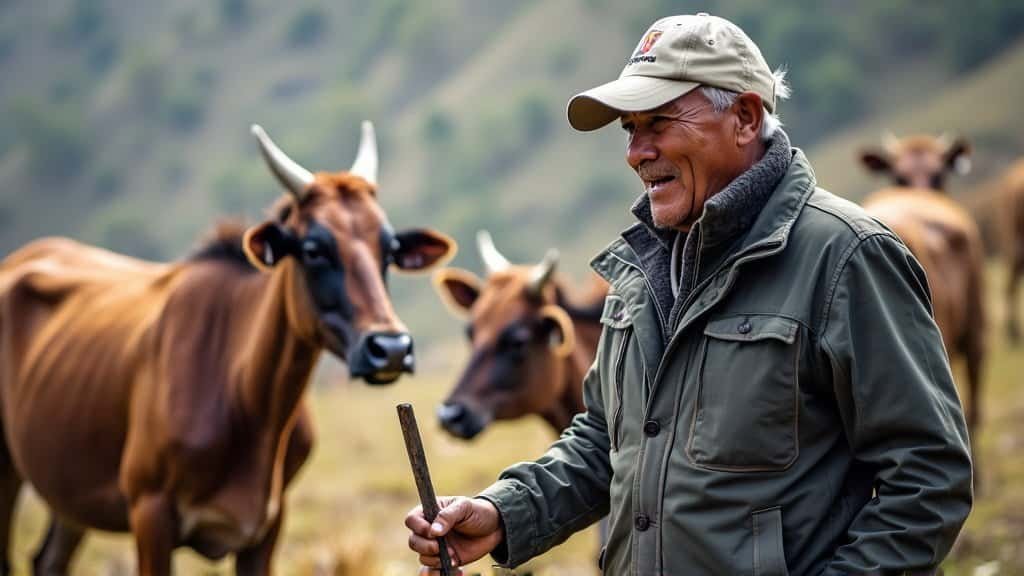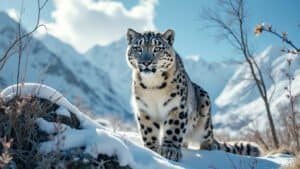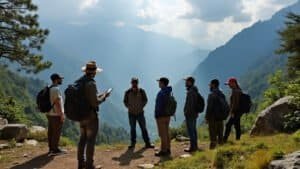Introduction
Educational programs are a cornerstone of snow leopard conservation efforts, helping to build awareness, foster community engagement, and reduce human-wildlife conflict
This article explores the various types of educational initiatives, from school-based programs to community workshops, and how they contribute to the protection of snow leopards. By integrating traditional knowledge with modern conservation strategies, these programs empower local communities and create long-lasting impacts on snow leopard populations
Understanding these educational efforts is key to supporting and expanding conservation initiatives that ensure the survival of this endangered species
Types of Educational Programs in Snow Leopard Conservation
Educational programs play a critical role in snow leopard conservation by engaging various segments of society—from students to local communities—in efforts to protect this endangered species
These programs vary widely in scope and approach, but all aim to increase awareness, foster positive attitudes toward snow leopards, and empower individuals and communities to take action. The following sections explore the primary types of educational programs used in snow leopard conservation: school-based programs, community workshops, and public awareness campaigns
School-Based Conservation Programs
School-based conservation programs are among the most effective ways to instill a sense of environmental stewardship in younger generations
These programs often incorporate snow leopard conservation into the broader curriculum, teaching students about the species, its habitat, and the threats it faces. By integrating conservation education into subjects like science, geography, and social studies, these programs help students understand the importance of biodiversity and the role they can play in protecting endangered species
One example of such an initiative is the Snow Leopard Trust’s education program, which works with schools in snow leopard range countries like Mongolia, India, and Kyrgyzstan
The program provides teachers with resources and training to deliver lessons on snow leopard ecology, the challenges of conservation, and the cultural significance of the species. Students learn not only about the biology of snow leopards but also about the importance of protecting their natural habitats and the ways in which humans can coexist with wildlife
These school-based programs often extend beyond the classroom, involving students in hands-on conservation activities such as habitat restoration projects, wildlife monitoring, and community outreach
For instance, students might participate in tree-planting initiatives that help restore degraded areas of snow leopard habitat, or they might help conduct surveys to monitor local wildlife populations. By engaging students in these activities, educational programs help cultivate a lifelong commitment to conservation and environmental stewardship
Community Workshops and Training
Community workshops and training sessions are vital components of educational programs aimed at snow leopard conservation
These initiatives are typically targeted at local communities living near snow leopard habitats, where human-wildlife conflict is a significant concern. By providing education and training, these programs help communities develop the skills and knowledge needed to protect snow leopards while also safeguarding their livelihoods
One key aspect of these workshops is educating local herders and farmers about non-lethal methods of protecting their livestock from snow leopards. For example, workshops might teach participants how to build predator-proof corrals, which prevent snow leopards from accessing livestock at night
These corrals have been successfully implemented in regions like the Indian Himalayas, where they have significantly reduced livestock losses and, consequently, retaliatory killings of snow leopards
Additionally, community workshops often focus on sustainable land-use practices that help preserve snow leopard habitats. Participants learn about the impact of overgrazing, deforestation, and other practices that degrade the environment and threaten snow leopard populations. By promoting sustainable alternatives, these programs help communities balance their economic needs with the goal of conservation
Training programs also play a crucial role in empowering local communities to take an active role in conservation efforts. For example, the Snow Leopard Conservancy in Nepal runs a program that trains local people to become citizen scientists
These trained individuals help monitor snow leopard populations by setting up camera traps, collecting data on snow leopard movements, and reporting signs of illegal hunting. This community-based approach not only enhances conservation efforts but also fosters a sense of ownership and pride among local people
Public Awareness Campaigns
Public awareness campaigns are designed to reach a broader audience, both locally and globally, with the message of snow leopard conservation
These campaigns use various media, including print, radio, television, and social media, to educate the public about the importance of protecting snow leopards and the threats they face. By raising awareness on a large scale, these campaigns aim to generate public support for conservation initiatives and encourage positive changes in behavior
A successful example of a public awareness campaign is the International Snow Leopard Day, celebrated annually on October 23rd. This event, organized by the Global Snow Leopard and Ecosystem Protection Program (GSLEP), includes a wide range of activities, from educational workshops and community events to social media campaigns that reach millions of people worldwide
The goal is to highlight the importance of snow leopard conservation and to mobilize support from governments, NGOs, and the public
Social media plays a particularly powerful role in public awareness campaigns. Platforms like Instagram, Facebook, and Twitter allow conservation organizations to share information, stories, and images of snow leopards with a global audience
These campaigns often include hashtags, challenges, and user-generated content that encourage people to spread the word and get involved in conservation efforts. The viral nature of social media can amplify the impact of these campaigns, reaching people who might not otherwise be aware of snow leopard conservation issues
Public awareness campaigns are also essential for addressing misconceptions and changing attitudes toward snow leopards. For example, in some regions, snow leopards are viewed as a threat to livestock and livelihoods, leading to negative attitudes and retaliatory killings
Public awareness efforts aim to shift these perceptions by emphasizing the ecological importance of snow leopards, the benefits of biodiversity, and the availability of non-lethal methods to protect livestock
The Role of Educational Programs in Reducing Human-Wildlife Conflict
Human-wildlife conflict is one of the most significant threats to snow leopard conservation, as it often leads to retaliatory killings when snow leopards prey on livestock
Educational programs play a crucial role in mitigating this conflict by equipping local communities with the knowledge and tools needed to protect their livelihoods without harming the snow leopards. By promoting coexistence strategies and fostering a deeper understanding of the ecological importance of snow leopards, these programs help to reduce tensions and create a more harmonious relationship between humans and wildlife
Educational programs are most effective when they are tailored to the specific needs and challenges of the communities they serve. This approach ensures that the solutions provided are relevant and sustainable, making it more likely that they will be adopted and maintained over the long term
The following sections explore how educational programs contribute to reducing human-wildlife conflict through targeted education for local herders and farmers, the promotion of coexistence strategies, and success stories from the field
Educating Local Herders and Farmers
Local herders and farmers are often on the front lines of human-wildlife conflict, as their livestock represents a significant source of income and security. When snow leopards prey on these animals, it can lead to substantial economic losses, which in turn can fuel negative attitudes toward snow leopards and increase the likelihood of retaliatory killings
Educational programs aimed at these communities focus on reducing livestock losses through non-lethal means, thereby protecting both the livelihoods of the people and the lives of the snow leopards
One of the key strategies taught in these programs is the use of predator-proof corrals. These structures are designed to keep snow leopards out, particularly at night when attacks are most likely to occur. By constructing sturdy enclosures with strong materials and secure roofs, herders can significantly reduce the chances of losing livestock to snow leopard predation
In regions like Ladakh, India, such corrals have been highly successful, leading to a marked decrease in livestock losses and a corresponding reduction in retaliatory killings
Educational programs also teach herders how to better manage their livestock to minimize the risk of predation. For example, herders might be encouraged to keep their animals in larger, more easily monitored groups, or to use guard animals such as dogs to deter snow leopards
Additionally, these programs often include training on how to recognize and avoid areas where snow leopards are known to hunt, thereby reducing the likelihood of encounters between livestock and predators
Beyond these practical measures, educational programs also work to change the way herders and farmers perceive snow leopards
By emphasizing the ecological role of snow leopards as apex predators and the benefits of biodiversity, these programs aim to foster a greater appreciation for the species and a willingness to coexist with it. This shift in attitude is essential for long-term conservation success, as it reduces the desire for retribution when livestock losses do occur
Promoting Coexistence Strategies
Promoting coexistence between humans and snow leopards is a central goal of educational programs focused on reducing human-wildlife conflict
Coexistence strategies involve finding ways for people and snow leopards to share the same landscapes without coming into direct conflict. These strategies are often based on a combination of traditional knowledge and modern conservation techniques, ensuring that they are both effective and culturally appropriate
One effective coexistence strategy is the development of community-based conservation initiatives, where local people are actively involved in protecting snow leopards and their habitats. Educational programs help communities organize and implement these initiatives, providing training on wildlife monitoring, habitat restoration, and conflict resolution
For example, in Nepal, the Snow Leopard Conservancy works with local communities to establish “Conservation Committees,” which are responsible for overseeing conservation activities and resolving conflicts when they arise
Another important coexistence strategy is the implementation of livestock insurance programs. These programs, which are often introduced through educational workshops, provide financial compensation to herders who lose livestock to snow leopard predation
By reducing the economic impact of these losses, insurance programs decrease the incentive for herders to kill snow leopards in retaliation. Educational programs play a key role in explaining how these insurance schemes work and encouraging participation among local herders
Educational programs also promote the use of non-lethal deterrents to protect livestock from snow leopards. These deterrents can include noise-making devices, lights, and scent-based repellents, all of which are designed to keep snow leopards away from livestock without causing them harm
By teaching herders how to use these deterrents effectively, educational programs help to prevent conflicts before they occur, creating a safer environment for both people and snow leopards
Success Stories from the Field
The success of educational programs in reducing human-wildlife conflict can be seen in several case studies from snow leopard range countries
These success stories demonstrate the effectiveness of targeted education and the positive impact that well-designed programs can have on both conservation outcomes and community well-being
One notable example comes from Mongolia, where the Snow Leopard Trust has worked closely with local herders to implement predator-proof corrals and livestock insurance programs
These initiatives, supported by educational workshops and training sessions, have led to a significant reduction in snow leopard killings in the region. As a result, snow leopard populations have stabilized, and herders have reported fewer livestock losses, leading to a more positive attitude toward snow leopards and conservation in general
In Pakistan, the Baltistan Wildlife Conservation and Development Organization (BWCDO) has successfully integrated educational programs into its snow leopard conservation efforts. The organization runs workshops for local communities that focus on non-lethal predator control, sustainable livestock management, and the cultural significance of snow leopards
These programs have not only reduced human-wildlife conflict but have also fostered a strong sense of ownership and pride among local people, who now see themselves as stewards of the snow leopard’s habitat
These success stories highlight the importance of educational programs in achieving lasting conservation results. By reducing human-wildlife conflict and promoting coexistence, these programs help to ensure that snow leopards can continue to thrive in the wild, while also supporting the livelihoods and well-being of the communities that share their landscapes
How Educational Programs Raise Awareness About Snow Leopard Threats
Educational programs are essential tools in raising awareness about the various threats that snow leopards face, from habitat loss and climate change to poaching and human-wildlife conflict
By informing and engaging different audiences—ranging from local communities to the global public—these programs help build a widespread understanding of the importance of snow leopard conservation and the urgent need to protect this endangered species
This section will explore how educational programs contribute to awareness-raising efforts through understanding the threats to snow leopards, engaging the global community, and utilizing the power of media and storytelling
Understanding the Threats to Snow Leopards
Educational programs often begin by helping participants understand the specific threats that snow leopards face in their natural habitats
These threats include habitat fragmentation due to human development, illegal hunting for fur and bones, and the impact of climate change on their mountainous ecosystems. By providing detailed information on these issues, educational programs aim to create a comprehensive understanding of why snow leopards are endangered and what can be done to mitigate these threats
For example, participants in educational workshops might learn about the effects of climate change on snow leopard habitats, such as the melting of glaciers that reduces water availability and alters prey patterns
These changes can force snow leopards to move into areas closer to human settlements, increasing the likelihood of conflict. Understanding these dynamics is crucial for developing effective conservation strategies, and educational programs ensure that both local communities and the broader public are informed about these complex issues
In addition to ecological threats, educational programs also address the social and economic factors that contribute to the decline of snow leopard populations. These factors include poverty, lack of economic opportunities, and cultural attitudes toward wildlife
By exploring these underlying causes, educational programs help participants understand the broader context of snow leopard conservation and the importance of addressing these root issues
Engaging the Global Community
While snow leopards are found in remote, mountainous regions of Asia, the effort to conserve them requires global support
Educational programs play a key role in engaging the international community by raising awareness about the importance of snow leopard conservation and encouraging people from all over the world to take action. This global engagement is crucial for generating the resources, political will, and public support needed to protect snow leopards
One way that educational programs engage the global community is through partnerships with international organizations, schools, and universities
These partnerships often involve collaborative projects, research initiatives, and educational exchanges that bring together people from different countries to work on snow leopard conservation. For instance, the Snow Leopard Trust collaborates with institutions around the world to promote snow leopard conservation through research, education, and advocacy
Global awareness campaigns are another important aspect of engaging the international community. Educational programs often include components that encourage participants to spread the word about snow leopard conservation through social media, public events, and fundraising activities
For example, participants might be asked to organize awareness-raising events in their own communities or to share information about snow leopards with their networks online. These efforts help to amplify the conservation message and reach a wider audience
Educational programs also engage the global community by highlighting the connections between snow leopard conservation and broader environmental and social issues, such as climate change, biodiversity loss, and sustainable development. By linking snow leopard conservation to these global challenges, educational programs make it clear that protecting this species is not just a local or regional concern, but a matter of global importance
The Power of Media and Storytelling
Media and storytelling are powerful tools used by educational programs to raise awareness about snow leopards and the threats they face
Through documentaries, films, social media campaigns, and other forms of media, these programs bring the story of snow leopards to life, making it accessible and engaging for a wide audience. By telling compelling stories about snow leopards, their habitats, and the people who live alongside them, educational programs can inspire empathy, concern, and action
Documentaries and films are particularly effective in raising awareness because they allow viewers to see snow leopards in their natural environment and to witness the challenges they face firsthand. For example, the documentary Ghost of the Mountains provides an intimate look at the lives of snow leopards in the Himalayas and the efforts to protect them. Such films can reach a global audience, raising awareness and generating support for conservation initiatives
Social media is another powerful medium for storytelling in snow leopard conservation. Educational programs often use platforms like Instagram, Facebook, and YouTube to share photos, videos, and stories about snow leopards
These posts can go viral, spreading awareness quickly and reaching people who might not otherwise be exposed to conservation messages. By using hashtags, challenges, and interactive content, these campaigns can engage a broad audience and encourage them to learn more about snow leopard conservation
Storytelling is also an important component of educational programs aimed at local communities. By sharing stories about the cultural significance of snow leopards, the challenges of conservation, and the successes achieved through community-based efforts, these programs help to build a narrative that resonates with local people
This approach can be particularly effective in changing attitudes toward snow leopards and encouraging communities to take pride in their role as stewards of this iconic species
Integrating Traditional Knowledge into Snow Leopard Conservation
Traditional knowledge, passed down through generations, is a valuable asset in the conservation of snow leopards. Many indigenous and local communities living in snow leopard habitats have coexisted with these big cats for centuries, developing a deep understanding of the species and its environment
Educational programs that integrate this traditional knowledge with modern conservation science can create more effective and culturally relevant strategies for protecting snow leopards
This section explores the importance of indigenous knowledge, case studies of community-led conservation, and the ways in which traditional practices can be bridged with scientific approaches
The Importance of Indigenous Knowledge
Indigenous knowledge encompasses a wide range of understandings about the natural world, including animal behavior, plant uses, weather patterns, and ecological relationships. For communities living in close proximity to snow leopards, this knowledge is critical for navigating the challenges of coexistence
Traditional practices often include methods for protecting livestock, managing land, and interpreting wildlife behavior, all of which can contribute to effective snow leopard conservation
For example, many herders in Central Asia have developed techniques for minimizing livestock losses to predators, such as rotating grazing areas to avoid places where snow leopards are known to hunt
They also have a rich understanding of the landscape and its resources, which can help identify key areas for conservation. By integrating this knowledge into educational programs, conservationists can ensure that their strategies are aligned with the experiences and needs of local communities, making them more likely to succeed
Indigenous knowledge also plays a crucial role in fostering a sense of ownership and responsibility for conservation among local communities
When conservation efforts are built on a foundation of traditional practices, they are more likely to be embraced and sustained by the people who live in snow leopard habitats. This cultural alignment can help bridge the gap between conservation goals and the daily realities of life in these regions
Case Studies of Community-Led Conservation
Community-led conservation initiatives that incorporate traditional knowledge have shown significant success in protecting snow leopards. These initiatives are often driven by the communities themselves, with support from NGOs and educational programs that provide training and resources
The following case studies highlight the effectiveness of this approach:
Mongolia’s Snow Leopard Enterprises: In Mongolia, the Snow Leopard Trust has partnered with local herders to create Snow Leopard Enterprises, a conservation initiative that combines traditional crafts with wildlife conservation. Herders produce traditional woolen handicrafts, which are sold through the Snow Leopard Trust’s global network
In return, participating communities agree to protect snow leopards and their habitats. This program not only provides economic incentives for conservation but also strengthens traditional crafts and cultural practices. The integration of traditional knowledge into this initiative has been key to its success, as it respects and supports the herders’ way of life while promoting snow leopard conservation
The Annapurna Conservation Area, Nepal: In Nepal’s Annapurna region, the Annapurna Conservation Area Project (ACAP) has worked with local communities to integrate traditional land management practices with modern conservation techniques
This collaboration has led to the establishment of community-managed conservation areas, where traditional grazing practices are maintained alongside efforts to protect snow leopard habitats. Educational programs have played a critical role in this process, providing training on sustainable practices and facilitating the exchange of knowledge between local people and conservation scientists
The result has been a reduction in human-wildlife conflict and a more resilient ecosystem that supports both snow leopards and local livelihoods
The Pamir Mountains, Tajikistan: In the Pamir Mountains of Tajikistan, a community-based conservation program has successfully combined traditional hunting practices with modern wildlife management. The program, supported by NGOs and government agencies, involves local hunters in the monitoring and protection of snow leopard populations
Hunters use their knowledge of the landscape and wildlife to track snow leopards and prevent illegal hunting. Educational programs provide additional training in wildlife monitoring techniques and data collection, helping to bridge traditional practices with scientific research. This approach has led to a significant increase in snow leopard sightings and a decrease in poaching incidents
These case studies demonstrate the potential of community-led conservation initiatives that integrate traditional knowledge. By building on the strengths of local practices and engaging communities as active participants in conservation, these programs create sustainable and culturally appropriate solutions for protecting snow leopards
Bridging Science and Tradition
One of the key challenges in snow leopard conservation is finding ways to bridge traditional knowledge with modern scientific approaches
Educational programs play a vital role in this process by facilitating dialogue and collaboration between local communities and conservation scientists. This collaborative approach ensures that conservation strategies are both scientifically sound and culturally relevant
For instance, scientific methods such as camera trapping and GPS collaring can be used in conjunction with traditional tracking techniques to monitor snow leopard populations more effectively
Local trackers, who have an intimate knowledge of the landscape and snow leopard behavior, can provide invaluable insights that enhance the accuracy and efficiency of these monitoring efforts. Educational programs that train local people in the use of modern technologies, while also valuing their traditional skills, create a powerful synergy that benefits both conservation and community well-being
Moreover, educational programs can help adapt traditional practices to the changing environmental and social conditions in snow leopard habitats
As climate change and development alter these landscapes, some traditional practices may need to be modified or combined with new approaches to remain effective. By working together, scientists and local communities can develop innovative solutions that draw on the best of both worlds
In addition to bridging knowledge systems, educational programs also foster mutual respect and understanding between conservationists and local people. By recognizing the value of traditional knowledge and involving communities in the decision-making process, these programs build trust and collaboration, which are essential for the long-term success of conservation efforts
Conclusion
Educational programs are a cornerstone of snow leopard conservation, playing a vital role in raising awareness, reducing human-wildlife conflict, and integrating traditional knowledge with modern science
These programs help to build a global community committed to protecting snow leopards by educating diverse audiences—from local herders to international supporters—about the challenges these big cats face
By fostering a deeper understanding of snow leopard ecology, promoting coexistence strategies, and respecting indigenous knowledge, educational initiatives empower communities to take an active role in conservation. As these programs continue to evolve, they will be instrumental in ensuring the survival of snow leopards and the preservation of their mountainous habitats for future generations








